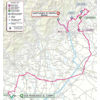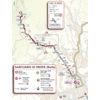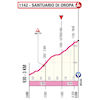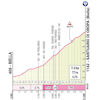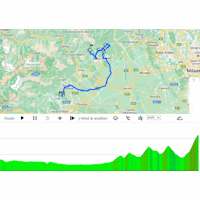Giro 2024 Route stage 2: San Francesco al Campo - Oropa
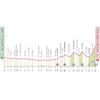
Slideshow 1/13
Sunday 5 May - The riders travel from San Francesco al Campo to the Santuario di Oropa on the second day of the Giro d'Italia. The 161 kilometres long route rises at 6.2% to the line in the last 11.8 kilometres.
Oropa is the earliest summit finish in the Italian Grand Tour since 1989. Back then, Acácio da Silva climbed to victory on Mount Etna.
The climb to Oropa was last included in 2017. At an elevation of 1,142 metres, the sanctuary is reached after a 11.8 kilometres climb at 6.2% with steepest sectors of up to 13%. It is an irregular ascent with the most unwelcoming sectors from kilometre 5 onwards.
In 2017, Nairo Quintana attacked halfway up the finish climb. Maglia rosa Tom Dumoulin set of in pursuit with Mikel Landa, Vincenzo Nibali, Adam Yates and Ilnur Zakarin in his wheel. The Dutchman shrugged off Nibali and Yates before he closed the gap to Quintana. Dumoulin countered a late attack by Zakarin just before the final straight to the Oropa Sanctuary. The maglia rosa dug deep and passed the Russian on the cobbles to the line to win the race and cement his overall lead.
Enrico Battaglin took the flowers in Oropa in 2014, while the photogenetic sanctuary formed also the backdrop in the infamous 1999 stage when Pantani flatted at the bottom. The Italian then overtook 49 riders in the last 8 kilometres to win the stage. Six days later he was removed from the Giro with his hematocrit exceeding the 50% limit that was then in place.
The run-up to the finish climb is nothing special. The first 85 kilometres are flat before two minor climbs take the riders to the medieval town of Biella, where the climb to the line kicks in.
The second and third intermediate sprint come with 3, 2 and 1 seconds, while the first three riders on the line gain 10, 6 and 4 seconds.
Ride the route yourself? Download GPX 2nd stage 2024 Giro d’Italia.
Another interesting read: results 2nd stage 2024 Giro.
Giro d’Italia 2024 stage 2: routes, profiles, videos
Click on the images to zoom
+ Click for more images (9)
Watch the highlights of recent races here:
Related articles Fiorelli takes ciclamen jersey - Giro 2024 The Route - Giro 2024 Route and stages - Giro 2024 Winners and records - Giro d'Italia Withdrawals - Giro 2024 Riders - Giro 2024 GC Favourites - Giro 2024 More articles Giro 2025: Live report Tirana ITT
Vuelta Femenina 2025: Vollering seals GC win at Alto de Cotobello
Vuelta Femenina 2025 Route stage 7: La Robla - Alto de Cotobello
Giro 2025 Route stage 2: Tirana - Tirana
Giro 2025 Favourites stage 2: Chrono specialists to the fore
Giro 2025 stage 2: Start times Tirana ITT
Giro 2025: Withdrawals
Giro 2025: The Route
Giro 2025: Riders
Giro 2025: GC Favourites
Giro 2025 Route stage 3: Valona – Valona
Giro 2025 Favourites stage 3: Breakaway day
Giro 2025 Route stage 4: Alberobello – Lecce
Giro 2025 Favourites stage 4: For fast men #1
Giro 2025 Route stage 5: Ceglie Messapica - Matera
Giro 2025 Favourites stage 5: For fast men #2
Giro 2025 Route stage 6: Potenza - Naples
Giro 2025 Favourites stage 6: Hilly race with flat finale
Giro 2025 Route stage 7: Castel di Sangro - Tagliacozzo
Giro 2025 Favourites stage 7: First mountain top finish
Giro 2025 Route stage 8: Giulianova – Castelraimondo
Giro 2025 Favourites stage 8: Attackers in the Apennines
Giro 2025 Route stage 9: Gubbio - Siena
Giro 2025 Favourites stage 9: Strade Bianche alla Giro
Giro 2025 Route stage 10: Lucca – Pisa
Vuelta Femenina 2025 Route stage 6: Becerril de Campos - Baltanás
Cycling Calendar 2025
Tour de France 2025: The Route
Tour de France 2025 Route stage 1: Lille - Lille
Tour de France 2025 Route stage 2: Lauwin-Planque - Boulogne-sur-Mer
Tour de France 2025 Route stage 3: Valenciennes - Dunkirk

